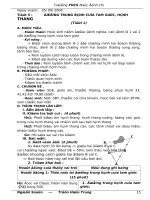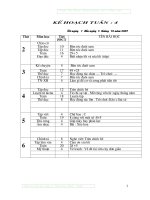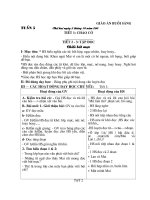- Trang chủ >>
- Mầm non - Tiểu học >>
- Lớp 5
5 6 2 mixed up vegetables (life science) TG
Bạn đang xem bản rút gọn của tài liệu. Xem và tải ngay bản đầy đủ của tài liệu tại đây (107.02 KB, 4 trang )
5.6.2
Mixed-Up Vegetables
SUMMARY
This book examines genetic
engineering as it applies to food. Many people
believe that altering food can help to solve
the world’s food shortage. Other people
believe that altering food is dangerous and
could bring harm to people and the Earth. The
book shows how farmers and scientists have
changed vegetables and the reasons for such
changes.
READ THE BOOK
SET PURPOSE
Have students set a purpose
for reading Mixed-Up Vegetables. Students’
curiosity about vegetables and genetic
engineering can guide this purpose. Since
this book presents many contrasting opinions,
students can decide which side of the
argument they support.
STRATEGY SUPPORT: TEXT STRUCTURE
LESSON VOCABULARY
beneficial
genetically altered
transgenic organisms
MAIN IDEA AND DETAILS
TEXT STRUCTURE
gene
pesticides
INTRODUCE THE BOOK
INTRODUCE THE TITLE AND AUTHOR
Discuss with
students the title and author of Mixed-Up
Vegetables. Based on the title and the cover
photograph, ask students to describe what
they imagine this book will be about.
BUILD BACKGROUND Ask students to discuss
the vegetables and fruits they like the best.
If they could change them, what sorts of
changes would they like to see? Is there a
particular fruit they enjoy that doesn’t grow
locally? Have students heard about genetic
engineering? Do they understand how
genetics work in people? Have them talk
about what they understand about genetics.
PREVIEW/USE TEXT FEATURES
Have students
look at the chapter headings and the
photographs and discuss how these text
elements help to organize the book. Ask
students how the chapter headings may help
them understand what the book may be
about.
Encourage
students to identify the book’s external text
structure, as evident in the title, headings,
paragraphs, charts, graphs, photos, and the
like. Then ask them to think about the way
the text is internally structured, i.e., the logical
connections between ideas. Guide students
to see that Mixed-Up Vegetables is internally
structured by comparing and contrasting the
two main views on genetic engineering (for or
against).
COMPREHENSION QUESTIONS
PAGE 3 What resulted when a gene from a
cold water fish was inserted into genes for a
tomato plant? (A tomato resulted that could
grow in colder weather than other tomatoes.)
PAGE 5
Other than genetic alteration through
experiments, what are two ways that farmers
have used for changing plants? (selective
breeding and grafting)
PAGE 7 What do you call plants or other
organisms that have had their genetic makeup
altered? (transgenic organisms)
PAGE 11
Nonmodified tomatoes are picked
when they are what color? (green)
PAGE 15 Do transgenic vegetables have to be
labeled as such? (no)
PAGE 16
Why can it be a problem when
scientists develop insect-resistant crops?
(Some insects develop a resistance to the
plants, making them more dangerous.)
116
Mixed-Up Vegetables
16924_LRD_TG_116-117 116
1/10/06 5:53:16 PM
REVISIT THE BOOK
READER RESPONSE
1. Possible response: Detail: Pests can
become resistant to genetically altered
poisons. Detail: Transgenic plants can be a
danger to other wildlife. Detail: Transgenic
vegetables can cause allergies. Main Idea:
Some people believe that genetic alteration
of vegetables is a mistake.
2. The headings are questions that provide
a purpose for reading. Possible outline for
page 5:
I. Plant alteration is not a new idea.
A. Selective breeding has been used for
years.
B. Grafting has been used for years.
3. genetic: having to do with origin and natural
growth; genetically: in a way that involves
genes; transgenic: having altered genes.
4. Responses will vary, but students should
support their answers.
EXTEND UNDERSTANDING
Discuss with students
how sections in books can help organize
complicated material. Go over all the boldface
heads with students and discuss what
material is in each section and why. Ask
students how they can tell what each section
is going to be about. Help them see that each
successive section is a progression.
RESPONSE OPTIONS
WRITING
Have students write a paragraph in
defense of genetic engineering of food or
against it. Have them use some of the details
from the book to support their case. Ask them
to consider who benefits from such genetic
manipulation or who is harmed by it.
SCIENCE CONNECTION
Have students research the
Flavr Savr tomato on the
Internet or in the newspaper.
Students should try to find out as much as
they can about the development of this new
tomato. They should check at their local
supermarket to see if that brand of tomato
is available. Ask the grocer if any of the
genetically modified foods are marked as
such. Can seeds for this tomato be bought at
the local nursery?
Skill Work
TEACH/REVIEW VOCABULARY
To reinforce the contextual meaning of the
word beneficial on page 4, discuss with
students how the phrase allows farmers to
grow much more helps to guess the meaning
of beneficial. Repeat this exercise with the
rest of the vocabulary words in the book.
Ask English language learners
to skim the article and write down any
unfamiliar words. Suggest they look the
words up in the dictionary and write the
meaning in their notebooks.
TARGET SKILL AND STRATEGY
MAIN IDEA AND DETAILS
Remind students
that each text can be boiled down to a
number of main ideas. Remind students that
each of the main ideas will be supported by
a number of supporting details. As they read
this text, have them take a piece of paper
and write down what the main ideas are.
Then have them list next to each main idea
the details that support it.
TEXT STRUCTURE
Remind students that
authors use different text structures to help
readers pay attention to certain details
about the topic. Point out to students that
most of the chapter headings in this book
are phrased as questions. Ask: Why did the
author structure the text in this way? Does
each chapter have a main idea?
ADDITIONAL SKILL INSTRUCTION
COMPARE AND CONTRAST Remind students
that when we compare two things we
examine how they are alike, and when we
contrast two things we examine how they
are different. In this text, the author often
contrasts the thoughts of people who are
for genetic engineering with the thoughts of
people who are against it. Have students
pay attention to these contrasting opinions
as they read the text.
Mixed-Up Vegetables
16924_LRD_TG_116-117 117
117
12/16/05 9:10:37 AM
Name
Mixed-Up Vegetables
Main Idea and Details
• The main idea is the most important idea about a topic.
• Supporting details are small pieces of information that tell more about the main idea.
Directions Use the diagram below to write the main idea and supporting details of
Mixed-Up Vegetables. Write the main idea in the center.
© Pearson Education 5
Directions Look at the chart on page 8. In the center of the diagram below, write the
main idea for the chart. Add four details that support the main idea.
118
16924_LRD_TG_118-119 118
12/16/05 9:11:02 AM
Mixed-Up Vegetables
Name
Vocabulary
Directions Write the vocabulary word that matches each definition.
Check the Words You Know
beneficial
genetically altered
transgenic organism
gene
pesticides
1. chemicals sprayed on crops to kill insects
2. contains genes that have been artificially inserted
3. a tiny unit that tells what a living thing will look like
4. something good or useful
5. genes that have been added to plants or animals to make changes
© Pearson Education 5
Directions Write a paragraph discussing the risks of genetically engineered vegetables as described
in Mixed-Up Vegetables, using as many vocabulary words as possible.
119
16924_LRD_TG_118-119 119
12/16/05 9:11:03 AM









